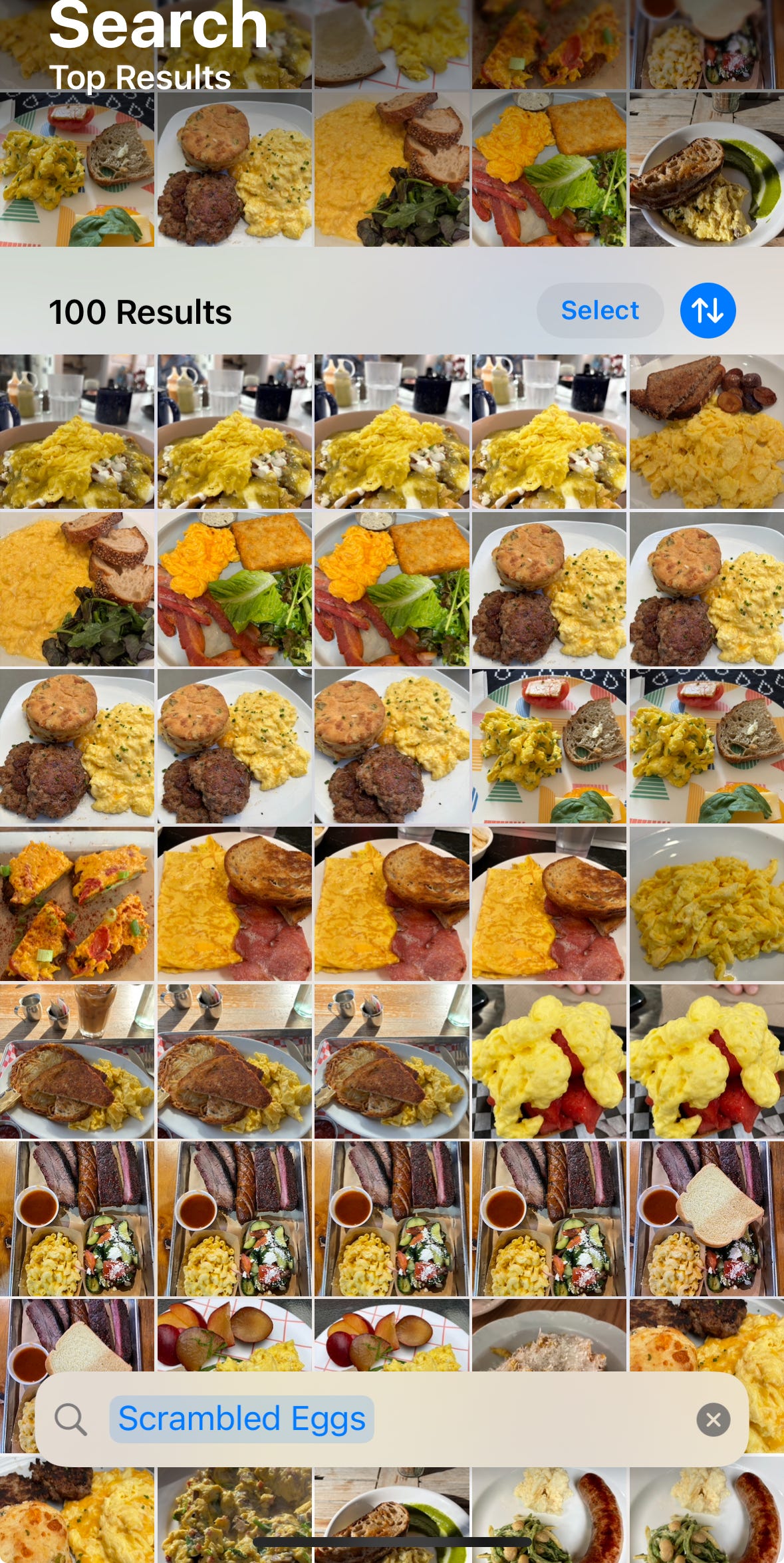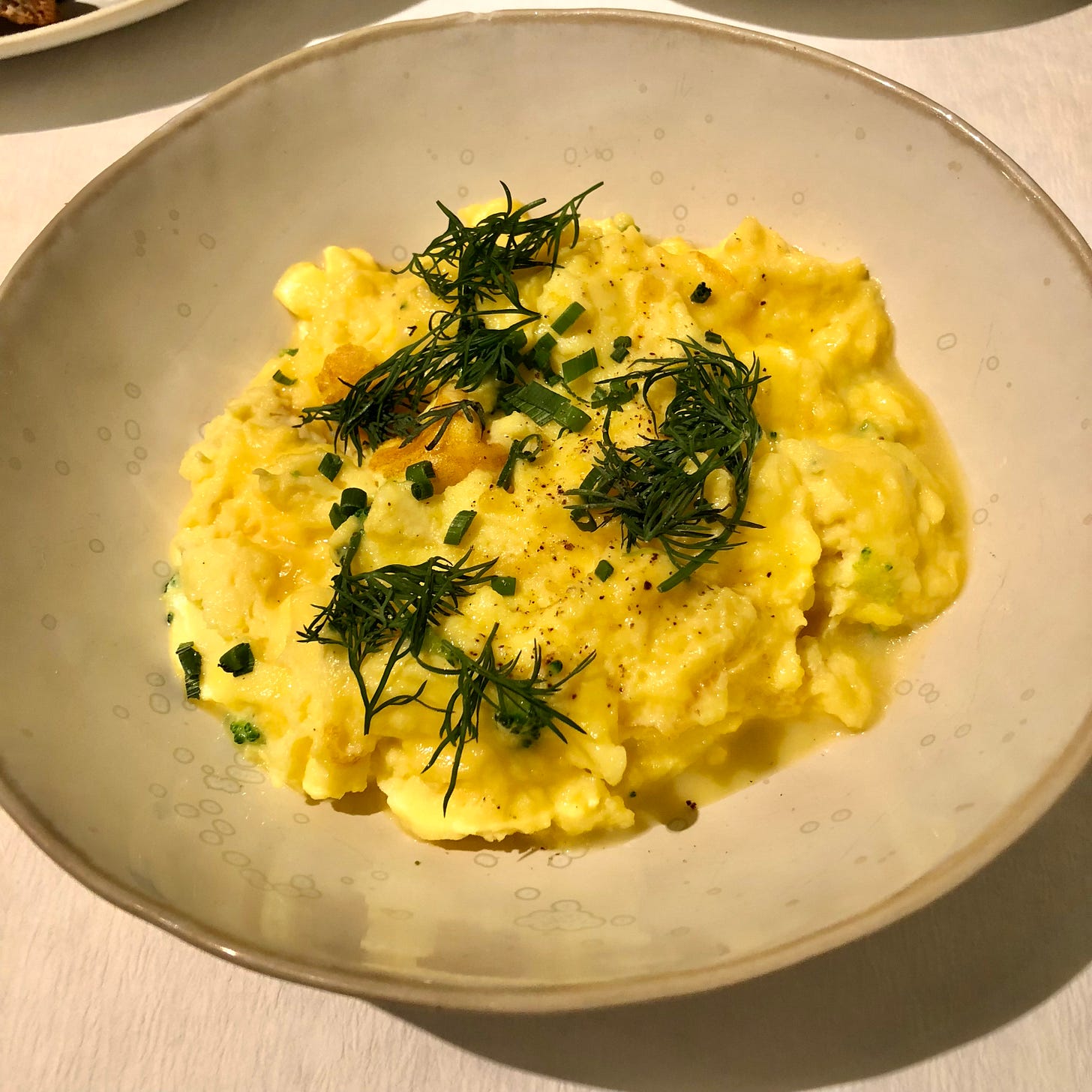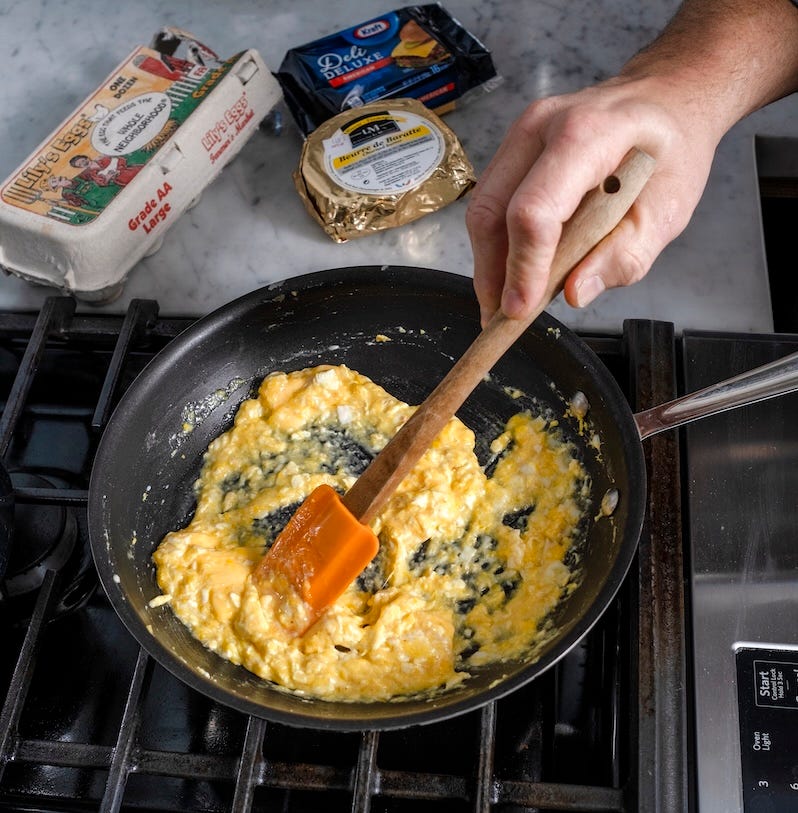Scrambled Eggs Curious
Here’s the thing: You really do need to cook them on low for 10 minutes.
I wanted to write about scrambled eggs because I might have just peaked in the kitchen with this last batch. The fresh eggs were really good and purchased at the Goshen Farmers Market from the nice people at Campanelli’s Poultry Farm in Kenoza Lake, NY. The cheese (there’s always cheese) was 5 Spoke Creamery’s Harvest Moon, a Mimolette-style raw cheese that melts beautifully and jumps off the table with a shade of orange that would fit right in on a 1980s-era San Diego Padres jersey. It’s the most soothing cheese shade.
I think of scrambled eggs as an at-home-only thing, with exceptions for the Delta lounge breakfast buffet—a great excuse to eat an obscene amount of eggs to protein maxx before a long flight—and one restaurant’s scrambled eggs specifically. Before the pandemic, I used to have breakfast meetings at abcV just off Union Square. It was the perfect place to meet at 9 a.m. on a weekday. Always bookable, with a great staff working the floor. When I spoke with Ayo Edebiri in 2022, she looked really familiar IRL, and we soon pieced it together that she was in fact the super kind person who had frequently been working the restaurant’s front door on weekday mornings. But a visit to abcV was all about the Rupert eggs.
Now, the Rupert in those eggs was the tangy Rupert alpine cheese from Vermont’s Consider Bardwell Farm. Cooked silky and folded with a shower of fresh dill, these are the scrambled eggs I judge all restaurant eggs by. Consider Bardwell (now sadly closed) was founded and run by my wonderful longtime literary agent, Angela Miller, and I once lunched with Angela over a plate of those eggs. The chef, naturally, came out to kiss the ring of Rupert.
I now want to present my way of cooking scrambled eggs, which I think is the only way. Debate away in the comments, please. I’m open-minded. Kind of.
“Cook me an egg!” It’s the request many young cooks are given when trying out for a job in the finest kitchens around the world—a make-or-break moment in all young kitchen professionals’ lives. Executing a perfectly cooked egg on the spot is not only the sign of a skilled line cook who has the chops to navigate an omelet, a poach, or an over-easy. It’s an opportunity to assess the cook’s behavior under pressure and see how she performs in the literal heat of the kitchen. And eggs are of course delicious, so there’s always the promise of a good snack at the test’s completion.
Unlike the folded omelet, the scramble—while it requires patience—doesn’t need any special pan or spatula skills. Scrambled eggs are about texture and flavor, not perfect edges and angles, which can send even the most slightly neurotic home cook into a spiral.
The first thing to keep in mind for perfect scrambled eggs is that you need much more butter than you think—like a teaspoon or more per egg. Butter adds flavor and richness, and it keeps the eggs from sticking to the pan. The second important factor is heat. Soft scrambled eggs require a very low flame for a longer amount of time than you might guess—in fact, properly scrambled eggs take upward of fifteen minutes for the best results. Cook them too quickly, and you’ll get big chunks of hard-cooked eggs mixed with a raw, runny mess, or worse yet, crunchy browned bits throughout. The goal is to slowly heat the eggs, mixing them constantly until they just set, then voilà. The best way to cook an egg.
A French omelet, which you may be wondering about, is simply scrambled eggs that have been allowed to cook for a final extra moment to set the outside into a shell. For a reference, check out the Jacques Pépin omelet video on YouTube, one of my favorite food things on the internet. I love it so much that I asked my friend
to write about it for TASTE in 2019.“It is difficult to make a real good omelet,” Pépin confirms in a silky French accent that reminds the viewer of his upbringing in Bourg-en-Bresse, before making two versions (the country omelet and the classic French omelet) in less than five minutes in the least difficult manner. Pépin is the sun all egg cooks revolve around. Long live the scrambled egg.
Scrambled Eggs with American Cheese
Makes 1 large portion
There is no dish more taken for granted than the scrambled egg. It makes sense—most Americans grow up eating aggressively cooked supermarket eggs for breakfast at home, or late at night with hash browns at the diner. The style in which those eggs landed on the plate can often be an afterthought. But gently scramble a farm-fresh egg, and the dish is a completely different experience. Rich and flavorful. Creamy and satisfying. Nowadays, diets are changing, and fatty breakfasts have fallen out of fashion. With that change, eggs have become less of a daily meal and more of a weekend indulgence.
So take advantage of the opportunity to eat better eggs when you do eat them—fresh from the farmers’ market is the best option. And a word on butter: Buy good, European-style butter, and use it to cook your scrambled eggs—it’s an integral ingredient, not just a coating to stop the eggs from sticking to the pan.
3 large eggs
1 tablespoon butter
2 slices American cheese, cut into 1-inch squares
1. Crack the eggs into a bowl and whisk them with 2 teaspoons of kosher salt and 2 tablespoons of cold water.
2. Melt the butter over a low-to-medium flame in a 10-inch nonstick skillet. Add the eggs, scraping out the bowl with a rubber spatula. Cook, continually stirring as they begin to heat. Avoid the temptation to accelerate the process. When the eggs begin to set, fold them so that no cooked eggs remain in contact with the pan long enough to set completely. This will take about 10 minutes.
4. When the eggs start to set, stir in the American cheese, and continue cooking until the cheese melts and disappears (about 2 minutes).
5. When the eggs resemble loose and wet cottage cheese, remove them from the heat and plate them immediately. The eggs will continue to cook after you remove them from the pan, so stop a little sooner than you think you should.
This essay and recipe is adapted from Food IQ: 100 Questions, Answers, and Recipes to Raise Your Kitchen Smarts. It’s a really fun book I wrote with my friend the chef Daniel Holzman of Danny Boy’s Pizzeria in Los Angeles. People who read Food IQ really like it too. I swear.







As a fellow egg connoisseur, I love this post, Matt. Going to give your ratios a go, if I can shed my Italian predilection to use olive oil in the pan instead of butter (gasp!).
For more egg-spiration check out the many proper omelet scenes in The Taste of Things, which has become one of my favorite movies of all time.
i’ve been to the abcV at Tin Building location but not the union square one. loved it though